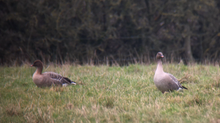A giant dung beetle
As a business we don't go actively hunting for awards, or prizes. So when I found out I had been nominated and then won the inaugural Russ Carrington Award, presented by the Pasture Fed Livestock Association, I was really chuffed. The award is given to a member of the PFLA who in the judges eyes is working to the further 100% grass fed production, communicates effectively and having some impact in taking the movement forward. To comemorate this there is a trophy...........
Now this is the really interesting bit. Not content with a shiny cup or certificate, you get to be custodian of a 3.5kg bronze dung beetle for a year. This fantastic sculpture was made by Mairi Hunt, a renown Dartmoor based sculptor of wildlife. She has sculpted everything from full size red deer to fish, otters and now the dung beetle. Have a look at her website here http://www.mairihuntsculpture.co.uk
We had a socially distanced hand over of the trophy here in December and I was lucky enough to meet Mairi, Russ and Sally-Ann Spence, the entomologist that is a champion of dung beetles and provided the specimen for Mairi to work from.

The beetle its self is a very accurate depiction of a Geotrupes spiniger , however a real G. spiniger would be no bigger than your little finger nail, so the sculpture is abbut 30 times bigger than life size.
Why a dung beetle? Well the key to producing excellent 100% grass fed beef is really the soil and biodiversity associated with it. If you want a healthy diverse sward of grass and other plants that are nutritious for stock, provide a habitat for wildlife and tolerant to drought or flood, then the ecosystem of your soil both at the surface and below ground must be in excellent shape. One of the key groups of organisms which help do this are dung beetles. Alot of us think of dung beetles rolling balls of dung, but in the UK we don't have any "rollers", we have "tunnellers" and "dwellers". Out of our 60 UK spieces 20 odd tunnel under a cow pat and drag dung down, 40 spieces dwell in the actual cow pat. All arrive at the dung by flying - some turn up with in 2 minutes of it "appearing". These beetles rapidly break down cow pats, recycling nutrients. Farmers who use high levels of insecticides (for treating flys, mite or ticks) can inadvertently decimate their dung beetle populations and end up with lots of dug not breaking down. So in short with out dung beetles we would be up to our neck in dung, and these under rated insects deserve more recognition.
All photos courtesy of Ian Boyd - Left Mairi Hunt, right Sally-Ann Spence Russ Carrington holding trophy
So do we have Geotrupes spiniger here on the farm? In summer 2019 we hosted Max Anderson a Phd student from the University of Sussex to look at the effects of dung beetle numbers and diversity and the associated bat populations on our farm and whether how you grazed your cattle effected beetles and bats. He identified 8 spieces out of 150 specimens. No G spiniger found this time. To read Max's paper on what he found click on this link https://www.mdpi.com/1424-2818/12/10/406/htm
If you want to know more about dung beetles, have a look at http://dungbeetlesforfarmers.co.uk










































Comentários